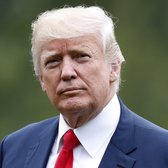Enact 5-year ban on White House and congressional officials from lobbying
Donald Trump
“First, I'm going to reinstitute a five-year ban on all executive branch officials lobbying the government for five years after they leave government. I'm going to ask Congress to pass this ban into law so that it cannot be lifted by executive order, right. Second, I'm going to ask Congress to institute its own five-year ban on lobbying by former members of Congress and their staffs.”
Trump-O-Meter

Promise Broken